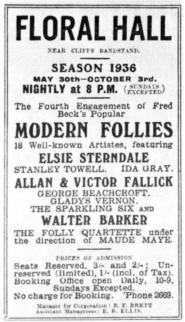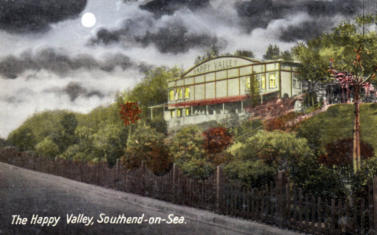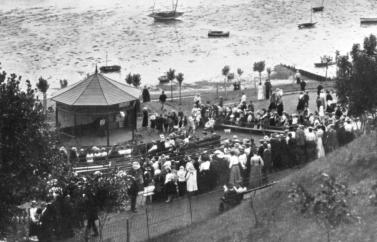Happy Valley & the Floral Hall

Southend-on-Sea
The
Happy
Valley
was
located
midway
between
what
is
now
the
Gentings
Casino
(Westcliff
Casino/Westcliff
Leisure
Centre)
and
what
was
the
Esplanade
Public
House
on
the
lower
level
of
Western
Esplanade,
it
was
running
before
1909.
The
original
Clifftown
Parade
bandstand
that
was
built
in
1902
was
relocated
to
the
Happy
valley
site
in
1909
as
the
Clifftown
site
was increased in size to cope with the demand of people visiting.
At
the
Happy
valley
site,
the
relatively
gentle
slope
of
the
cliffs
provided
a
natural
amphitheatre,
There
was
racked
seating
facing
a
stage
which
could
accommodate
an
audience,
a
charge
was
placed
upon
the
seating
area,
however, the footpaths to the back of the site remained free.
One
of
the
early
acts
was
the
music
hall
star
G.
H.
Chirgwin
(14th
December
-
17th
November
1922)
who's
face
paint
gave
him
the
nickname
of
the
White
Eyed
Kaffira,
his
act
would
be
a
mixture
of
cockney
material
as
well
as
straightforward
blackface
songs
and
sketches.
During
1913
the
Harry
Rose
Concert
Party
was
playing
twice
daily
concerts,
no
matter
what
the
weather
the band played on.
Happy
Valley
was
replaced
by
the
Floral
Hall
in
1920,
it
was
built
by
Herman
Darewski
who
operated
it
for
a
number
of
years
before
it
was
taken
over
by
the
Council.
The
hall
continued
to
be
used
for
concerts
as
well
as
flower
shows,
the
building
was
built
so
that
it
could
be
opened
up
in
hot
weather
or
kept
closed
in
cold
or
wet
weather.
To
keep
people
warm
in
the
winter
radiators were installed to heat the building.
Advance
booking
was
advised
to
avoid
disappointment,
performances
took
place
every
night
at
8:00pm
except
for
Sundays.
The
programme
was
changed
every
Monday
&
Thursday,
a
matinee
was
staged
on
Wednesdays
at
3:00pm
with
Grand
Gala
nights
every
Thursday.
The
Southend
Carnival
has
been
going
since
1906,
the
tradition
of
crowning
the
carnival
queen,
dates
back
to
1928
when
Ena
Bone
became
the
first
to
be
crowned
at
the
Floral
Hall.
During
the
1933
season
the
Floral
Hall
was
staging
"Modern
Follies."
Fred
Beck
and
his
cast
of
16
performers
were
the
resident
act
preforming
the
Follies
during
1933,
they
included:
Dorrie
Dee
who
proved
very
popular
with
constant
encores
at
the
end
of
her
act,
Thurza
Rogers
&
Lascelles
with
classical
&
eccentric
dancing,
Ena
&
Vera
Fawcett
doing
tap
dance,
Ann
performing
a
Blue
Danube
dance,
Tony
Drew
singing
baritone,
Madge
Villers
signing
soprano,
Fred
Beck
&
Dennis
Lawes
comedy
act
and
Reg
Lindo
&
Howard
Clark
on
pianos.
On
Thursday
12th
September
1935
the
South
African
and
Essex
cricket
teams
attended
the
Floral
Hall
as
the
guests
of
the
Parks
and
Entertainments
Committee,
the
event
was
also
attended
by
the
Mayor
&
Mayoress.
The
resident
lead
Fred
Beck
arranged
a
special
programme
for
the
evening
including
an
argument
between
Golf
and
Cricket,
Spanish
Serenade,
a
military medley and a musical burlesque.
The
Floral
Hall
would
remain
popular
until
the
tragic
events
of
Saturday
14th
August
1937,
Soon
after
4:00pm
a
young
lad
spotted
smoke
coming
from
part
of
the
building,
within
an
hour
the
building
was
left
as
nothing
but
a
twisted
skeleton
of
steel
uprights
and
cross
members,
the
intensity
of
the
fire
had
scorched
nearby
trees,
the
fire
fighters
had
to
act
quickly
to
stop
them
combusting
and
spreading
the
fire
up
the
cliff
gardens,
the
trees
survived
but
were
scorched.
As
the
fire
raged
hundreds
gathered
to
watch
the
unfolding
drama
despite
the
rain.
The
fire
had
happened
close
to
the
end
of
the
summer
season,
the
Council
started
to
look
at
what
they
could
do
for
next
season,
a
marquee
was
proposed
but
quickly
rejected
as
there
was
little
likelihood
that
an
entertainment
licence
would
have
been
granted
on
such
a
temporary
building
as
a
satisfactory
kitchen
and
sanitation
facilities
could
be
included
in
the
tented structure.
In
December
1937
it
was
proposed
to
build
a
café
on
the
north
side
of
the
site,
the
building
would
be
of
"Old
World"
type
construction,
being
built
from
weathered
Elm
&
Oak
boards
with
a
straw
&
heather
thatched
roof,
however,
the
plan
was
dropped
as
it
was
not
expected
to
have
been
ready
before
the
start
of
the
summer
season
and
that
the
flammable
construction
of
the
building
could
be
a
danger
to
further
fires.
The
Floral
Hall
had
been
fully
insured,
this
saw
a
pay
out
of
£6000
for
the
building,
£2000
for
fixture
&
fittings,
£4,
9s,
6d
lost
cash
box,
£31
lights
&
£200
for
two
pianos.
The
money
for
the
pianos
was
immediately
handed
over
to
Mr
T.
J.
Gilbert
of
100
High
Street
Southend,
who
had
leased
them
to
the
Council,
£10
was
handed
to
Messrs
B.
Roberts
&
Company of Leeds for the loss of advertising curtains.
At
the
time
of
the
fire
the
hugely
popular
Paramount
Follies
had
been
the
resident
show,
with
no
plans
in
place
to
replace
the
building, the Follies show closed.
With
no
time
to
construct
a
new
facility
it
was
decided
to
clear
gutted
remains
of
the
building
and
tidy
the
site
to
make
it
presentable
for
the
coming
season,
the
site
was
landscaped
to
become
part
of
the
Cliff
Gardens,
the
central
point
became
a
small
fish
pond,
after
a number of years the pond was filled in to become a flower feature.


Happy Valley
Floral Hall/Happy Valley Postcard
1936 Floral Hall Advert
Southend Timeline Southend-on-Sea © 2009 - 2024. All Rights Reserved




Southend-on-Sea’s No 1 History Website! Documenting The Town & The Townspeople

Now Incorporating The Sea Of Change Website
Website Info:


Chalkwell ▪ Eastwood ▪ Leigh-on-Sea ▪ Prittlewell ▪ Shoeburyness ▪ Southchurch ▪ Thorpe Bay ▪ Westcliff-on-Sea
SOUTHEND CITY
































































